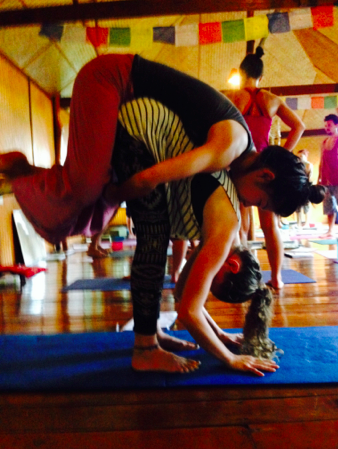Ready to quit your day job and become a yoga teacher?
I would like to share with you what really goes on behind the Namaste scene.
Being a yoga teacher presumes the role of teacher, mentor, friend, sage, field psychologist, career advisor and—depending on which style of yoga—an acrobat. If you desire to do what you love, practice yoga most days (if not every day) and have a thirst to learn and share ancient yogic philosophy, it’s a dream job!
I’m sure this sounds fantastic, aspiring and inspirational; I thought so. Some time ago, brave and naïve, I held on to this dream bubble, buckled my yogi belt and tenaciously embarked on my spiritual journey as a yoga teacher. Having worked in the yoga industry for a while now, I finally realized that teaching yoga doesn’t grant us a spiritual status automatically. As humans, at times we fail to meet expectations, deal with our insecurities on and off the mat and battle with our emotions on a consistent basis.
To break it down, I work for a yoga teacher training school.
Instead of teaching regular yoga classes, I get to meet yoga teacher aspirants from all over the world. I spend a month helping them become competent yoga teachers.
The first week is always the most interesting. I witness the vast differences in their ways of coping with new environmental changes, as well as the physical and mental demands of the course. Waking up at the break of dawn for meditation, soaking the yoga towels with sweat in the third yoga class of the day and being buried under pages of homework after a nine-hour day.
These are only a few of the many challenges.
As yoga teacher in this month long intensive, in addition to teaching yoga my job is to extend help, offer challenges, give hugs, encourage and listen with an open mind. After being “on” for at least nine hours, I need to fit in my asana practice, complete administrative work, mark homework and (if time allows) have personal downtime. I am the anchor, support and pillar. By week two, I was already drained.
Exhausted and on edge, I lashed out.
I lashed out at a student because she skipped an afternoon session without notice; and I took it personally. I used an accusatory tone, bluntly stated my concerns with non-acceptance and unsympathetically marched off. Reactively, she perceived my approach as offensive and outrageously mean. I, the yoga teacher who emphasized compassion and awareness, unwarily projected my frustration on a student. How ludicrous?
Upon reflection, I made a bad decision to approach her when I was in an agitated state. A disgruntled mind couldn’t possibly make sound choices. I could’ve waited, observed my internal state and calmly addressed the issue. Rippling from the negative effect, I felt guilty and defeated. My role as an anchor and support vanished in a blink of an eye. I failed to step up to the game.
In the eyes of the student, I may have come across hypocritical and surprisingly like a “normal” human being. Yoga students often perceive their teachers as great saints reincarnated from a mystical galaxy that houses pixies and Darth Vaders. We might only be 30-something (or younger) and drink, eat crap, sleep late and yes—experience intense PMS every month.
Of course, not all yoga teachers are like this, but the reality is we do not live in caves, breathe air for breakfast and only chant mantra and not karaoke. In defense of the students, yoga teachers also need a quick reality check. We’re no sages. Patanjali was, not us.
When office workers check into their offices, we Namaste our way to the beginning of our “office day.”
Until I detach from all human emotions, desires and mortality, I just have to continue to deal with my pride, sadness, insecurities and so on. In fact, despite being a teacher or not, we’re all mere mortals who might just prefer matcha to beer and vinyasa over aerobics. So let us all come down from our levitated magic carpets and keep it real.
After a long sleepless night, I put away my over-ridden ego and went to my student.
“I’m sorry.”Those simple words rolled nervously off my trembling tongue and bounced off my inner walls of fear. The following millisecond of silence I swear seemed like an eternity.
“ Me too.”Simply stated and that was it, a drama that arose from miscommunication, unawareness and projection ended just as easily as it was created.
I’ve learned from a wise swami that imperfection enriches a person. That way you always have something to learn from. I learned from my imperfection that apologizing for our wrongdoings takes courage and honesty. Not because we’re the teacher; we all have the right to say what we want and do what we like.
In truth, staying on the path of yoga takes practice and tenacity. I’m no different than my students. I may have started my journey earlier than them and with mystical karmic forces, I somehow ended up on the other side of the classroom.
Every day—every moment—I strive to apply what I learn in yoga to my daily life.
Nevertheless, I realize that walking the talk takes conscious effort and unwavering determination. In this modern society, a yoga teacher is not a guru or master of universal life force. A yoga teacher gives it all to their students at their best capacity.
We may slip at times. Our emotions take over and we make humanly mistakes. That doesn’t make us bad teachers, just better students.
So before you embark on the journey to become a yoga teacher, check in with yourself. Are you ready to continuously give, learn and practice? Real yoga is what happens within.
If you’re ready, don’t wait. The greatest job is out there waiting for you.
Love elephant and want to go steady?
Sign up for our (curated) daily and weekly newsletters!
Editorial Assistant: Jennifer Moore / Editor: Renee Picard







Read 0 comments and reply